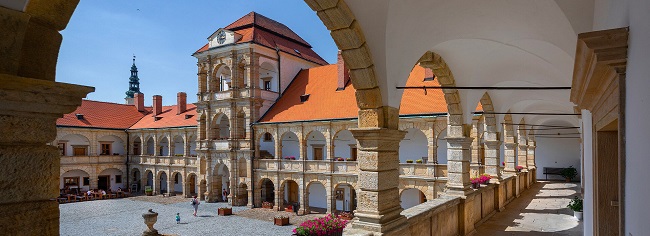
The castle in M. Třebová and the baroque palaces in Prague will be national cultural monuments
 |
Prague - The Castle in Moravská Třebová, the church and chapel with a ossuary in Sedlec near Kutná Hora, and the church with catacombs and the building of the Latin school in Klatovy will receive the status of national cultural monuments, which is the highest level of monument protection. Nine Baroque palaces in Prague will also become national cultural monuments, as approved by the government in its decree today. After the meeting, Culture Minister Martin Baxa (ODS) told journalists. The decree will take effect on July 1 of next year, the Ministry of Culture informed in a press release.
Six of the Prague palaces affected by the decree are owned by the state, two by the capital city, and the Archbishop's Palace is a church property. The Ministry of Foreign Affairs oversees two of the palaces in Hradčany - Černín Palace and Tuscan Palace. The Nostitz Palace in Malá Strana houses the proposing Ministry of Culture. The National Gallery Prague takes care of three palaces on Hradčany Square - Schwarzenberg, Salm, and Sternberg Palaces. The remaining two palaces in the Old Town are owned by Prague: Clam-Gallas Palace and Colloredo-Mansfeld Palace.
Among the monuments outside Prague affected by the decree is the Renaissance castle in Moravská Třebová in the Svitavy region. This architectural gem documents the development of Renaissance architecture in Central Europe and its changes from the 15th to the 17th century. It was initiated by the Lords of Boskovice, who began the reconstruction of the inconvenient castle in 1485 under the influence of Italian builders' ideas. It is one of the oldest Renaissance monuments north of the Alps.
The Moravská Třebová Castle was acquired from the state after 1989. According to Mayor Pavel Charvát (ODS), the monument was in a dilapidated state. The city repaired it thanks to subsidies. Charvát considers the status of national cultural monument a recognition of the castle's value and the care for it. "We take this as a gold medal for having also received the title of Historical Town of the Year 2024," said the mayor to ČTK.
The Gothic Church of the Assumption of the Virgin Mary and St. John the Baptist in Sedlec in Kutná Hora was baroque altered by Jan Blažej Santini-Aichel. The state has long been repairing the monument with funds from the Ministry of Culture. The All Saints' Chapel with ossuary will also become a national cultural monument in Sedlec. According to Radka Krejčí from the Roman Catholic Parish Kutná Hora – Sedlec, this step for the Cathedral of the Assumption of the Virgin Mary and St. John the Baptist should have come sooner, given that it is a monument on the UNESCO list.
"We are fully aware of the uniqueness of the All Saints' Church with ossuary on a global scale, and we are also pleased that it has been awarded this highest status. However, we have certain concerns about the possible impacts that the change of status may bring," Krejčí noted in response to ČTK's inquiry. She pointed out that the ossuary has been undergoing extensive restoration funded exclusively by parish income for the eleventh year. "Although we have done a great deal of work, we are only about halfway through the entire process. Therefore, we believe that the new status will not have a negative impact on the pace of the ongoing rescue of this extraordinary monument," added Krejčí.
The Baroque Church of the Immaculate Conception of the Virgin Mary and St. Ignatius with catacombs and the building of the Latin school in Klatovy was initiated by the Jesuits. The construction of this Catholic landmark in Klatovy, which bears the signatures of architects Carlo Lurago and Kilián Ignác Dientzenhofer, lasted an entire century. It includes catacombs from the second half of the 17th century, where members of the Jesuit order and patrons found their final resting place.
According to the explanatory memorandum to the proposal, the Ministry includes individual buildings among national cultural monuments in such a way that the set provides a coherent picture of the spectrum of cultural heritage in a European context. Following the recent expansion of 13 objects, there are plans for the gradual declaration of other exceptionally valuable palaces in the historic core of the capital, the office announced in a press release. "The newly declared national cultural monuments not only represent top-notch architecture and art but also remind us of the rich spiritual, social, and political traditions that have shaped our country and contributed to the European cultural context," stated Baxa.
The English translation is powered by AI tool. Switch to Czech to view the original text source.
0 comments
add comment










